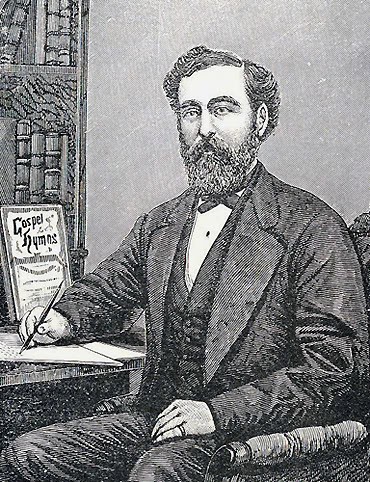History of Hymns: “Wonderful Words of Life”
By Jackson Henry
“Wonderful Words of Life” (“Sing them over again to me”)
by Philip P. Bliss
The United Methodist Hymnal, 600

Philip P. Bliss
Sing them over again to me,
Wonderful words of life;
Let me more of their beauty see,
Wonderful words of life;
Words of life and beauty
Teach me faith and duty.
Beautiful words, wonderful words,
Wonderful words of life.
I would wager that many people who have sung this hymn can recall most of the hymn text in its entirety or, at the very least, the refrain. Clearly, Philip P. Bliss (1838-1876) knew exactly what he was doing with this text. He used his background as an educator to influence many generations of singers over the course of the last century and a half.
Bliss is well known from his work with the evangelistic revival meetings of the mid-nineteenth century with leaders such as Dwight L. Moody (1837-1899) and Daniel Webster “Major” Whittle (1840-1901). Bliss and his wife, Lucy, both joined these revival meetings as singers, leading the songs of what would be known as the gospel era of hymnody. This genre of hymnody was itself named from collections Bliss compiled with Ira D. Sankey (1840-1908), with titles such as Gospel Hymns and Sacred Songs and Gospel Hymns No. 2. The Blisses defined the era with a life on the road as traveling evangelists with their colleagues for many years to come. Most of these worship services took place in the midwestern and the southern United States, and they served as the framework within which Bliss wrote his hymn texts and tunes.
Before these evangelistic endeavors, however, Bliss had an interesting life as a child and young adult. Born in Pennsylvania, the industrious boy spent his early years working and learning, and he received training in music from teachers such as William B. Bradbury (1816-1868), whose well-known tunes include JESUS LOVES ME and HE LEADETH ME. Bliss eventually took on the roles of itinerant music teacher, composer, and editor.
One can assume his training included the pedagogical tools needed to teach music in the nineteenth century, and it is evident this experience influenced his work as a composer and enlivener of the people’s song in worship. Bliss would have taught many of his songs in these revival meetings by rote, and “Wonderful Words of Life” is filled with examples of repetition. Though the second line differs from the first by only one note (the final note), it is almost an exact statement of the initial phrase. The third line contains two two-measure phrases that are exactly the same, and the refrain contains two phrases written almost note for note. The final musical form then becomes AA’ BB CC’.
In addition, the “wonderful words” themselves become a teaching tool that are deeply rooted in the ear, voice, and mind of the singer. The phrase “wonderful words” is repeated throughout this hymn a total of eighteen times, and the larger phrase “wonderful words of life,” a total of twelve times! He uses means other than repetition to reinforce the teaching of the text and tune. The poetic devices he employs also help to teach the hymn. “Words” is personified throughout the hymn as teachers “wooing us to heaven” and “offering pardon and peace to all.” Bliss’s creative use of alliteration is also very prominent throughout, with a strong “w” sound adding to the overall rocking character of the 6/8 tune. These poetic devices were carefully chosen because they all add to the narrative of the text and the singability of the tune.
As the revivalist song leader, Bliss was obviously emphasizing the words of Scripture and the subsequent “gospel call” that results from the hearing of these words. The singing itself becomes the persuasive sermon as the text is directed toward a listener, the “sinner,” and the sermon concludes with the following simple prayer:
Jesus, only Savior,
Sanctify forever.
It is no surprise, then, that this hymn is included in Methodist collections, as the themes of holiness and sanctification appear at the end of the third stanza.
If only Bliss could have written more texts and tunes, it is certain they would have appeared in United Methodist collections and others within the global church. His life was cut short at age 38 as he and Lucy were involved in a train wreck near Ashtabula, Ohio, on their way to Chicago to assist in evangelistic services led by “Major Whittle.” According to The Canterbury Dictionary of Hymnology, “It is believed that Bliss escaped the crash, but the carriages caught fire and he returned to try to save his wife” (JRW, “Philip P. Bliss”). Even the last moments of his life served as an example of one who followed the “gospel call.” As one learned in and devoted to “faith and duty,” Bliss spent his last efforts helping his wife, Lucy.
May the singing of these “wonderful words” be a reminder of the power of words, the Spirit moving through their proclamation, and the call of Christ.
For further reading:
JRW. "Philip P. Bliss." The Canterbury Dictionary of Hymnology. Canterbury Press, accessed June 7, 2017, http://www.hymnology.co.uk/p/philip-p-bliss.
Rev. Jackson Henry serves as Director of Music Ministries at First UMC, Franklin, Tennessee.
Contact Us for Help
Contact Discipleship Ministries staff for additional guidance.
